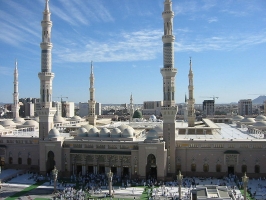Categories
Sponsored Links
Useful Links
Masjid Nabawi Madina

This pilgrimage is not mandatory as is the one to Makkah, but nevertheless popular. It is important to remember, however, that a visit to the Prophet’s grave is not in any way to worship or revere him, but to commemorate his role as God’s messenger, and to remind Muslims of his mortality and humanity.
The Prophet Muhammad(pbuh)’s Mosque was the first institution to be built following Prophet Muhammad(pbuh)’s migration in 622 AD from Makkah, where he was born, to the town of Yathrib, which became known as Madinah. Surrounded as it was by the shops and stalls of all kinds of merchants, the new mosque soon became the political and economic as well as the spiritual nucleus of the city, and played both a practical and a symbolic role in unifying the citizens, ultimately providing a solid foundation from which the Prophet and his companions could set forth and establish the Islamic state.
According to history, the manner in which the Prophet(pbuh) decided on its location, was to let his camel loose, and choose the site where it finally stopped to rest. The entire Muslim community, both the residents of Yathrib and those who had migrated from Makkah with the Prophet(pbuh), participated in the construction of this first mosque, which was simply an open courtyard about 805 square meters in area surrounded by a wall made from bricks and tree trunks. On the eastern side apartments were built to house the Prophet(pbuh) and his family.
By 629AD the Prophet(pbuh) had enlarged the area of the mosque to 2,475 square meters. Under the first four Caliphs, Madinah and the Mosque where the Prophet(pbuh) was buried continued to be the seat of government, reinforcing the synthesis of religion and governance in the Islamic state. The first two Caliphs, Abu Bakr(ra) and Umar(ra), were buried next to the Prophet(pbuh) in the place that had originally been the Prophet(pbuh)’s home, and which today is covered by the famous green dome of the mosque.
Masjid Nabawi, the final resting place of Prophet Muhammad (peace be upon him) is the second holiest place in Islam after the Masjid-ul Haram in Makkah.
Related News
Comments
You must login to post comments.

 Saudi Arabia
Saudi Arabia 
